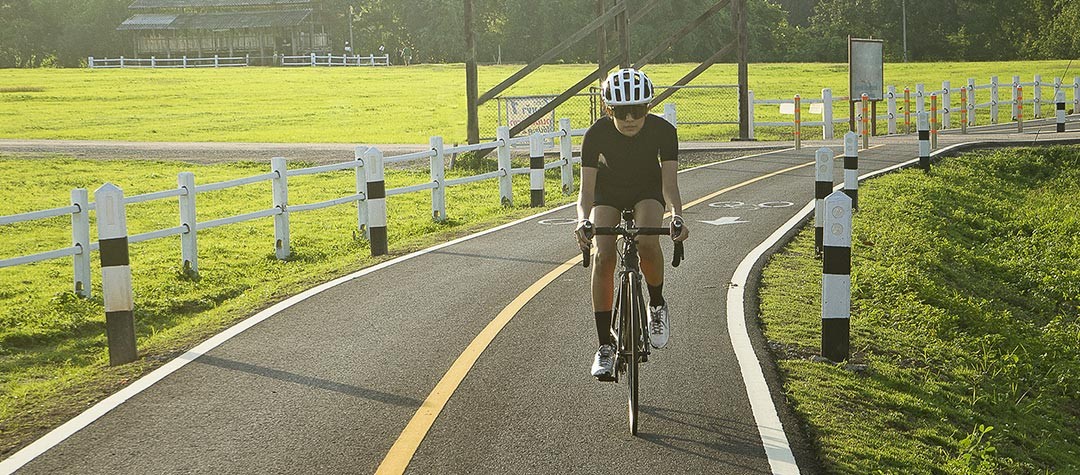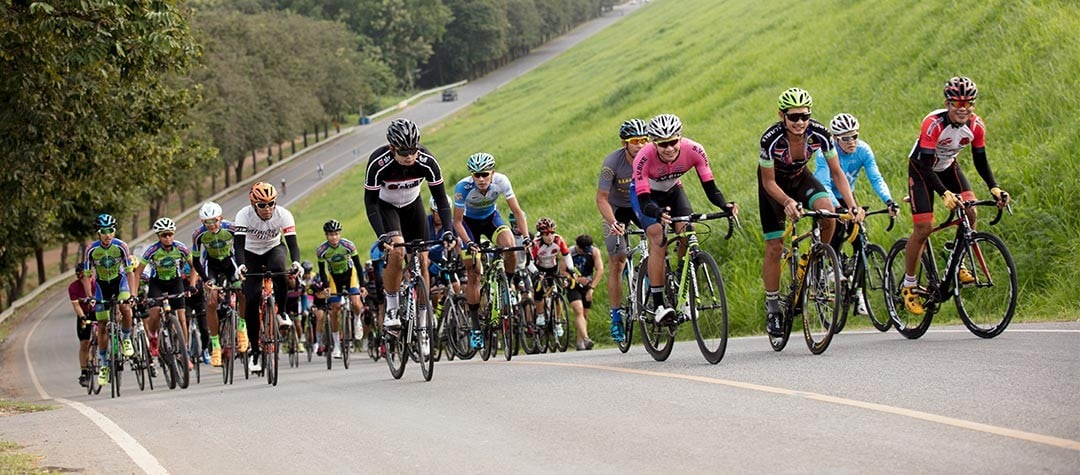Find out how you can develop that finishing burst and employ other tactics that will hopefully get you to the line before your competitors.
The ability to sprint is another important component of being a competitive cyclist. Some of us are born with an innate physiological ability to produce an explosive effort whilst others have to work on it. However, regardless of your natural ability you can make considerable improvements on your sprinting capacity if you incorporate sprints into your training. Its hard, but worth it!
As well as the physical elements of the sprint itself we’ll take a look at some other key factors to consider and be aware of when preparing to open up your thrusters as the chequered flag approaches…
Cycle sprint training
An important thing to mention before you even consider sprint training is that you should be free of any injury. Sprinting places a massive load on your joints and muscles, not to mention your cardiovascular system and training with even any residual injury could result in compounding any underlying issues.
There are many different training methods and sessions you can try but here I’m going to focus on two, both of which can be easily incorporated into your training routine. Although not a particularly gifted sprinter I used these sessions regularly, and although I didn’t turn into Mark Cavendish overnight, they certainly sharpened up my ability to accelerate; not only at the finish but also when accelerating hard out of corners or attacking to establish a breakaway.
SESSION 1: Consists of 1 hour. 8 x 10 sec ‘Slow Start’ sprints.
Key to any sort of high intensity training session is a warm up. So do a warm up of 15 minutes, gradually increasing your effort through the 15 minutes so you are breathing reasonably heavily and you feel ready to make some hard efforts.
These efforts are best done on quiet roads on a route that you know well. It could be a loop or you could find a flat section of road that you retrace to sprint along.
The session consists of 8 x sprints of 10 seconds with a 4 minute active rest between each effort. The sprints are from a very slow rolling speed of only 10 mph or so you really have to kick hard to gain momentum.
In between each effort just ride along spinning your legs on a low gear to recover before gearing up again into the sprocket you will start the sprint in. An ideal gear is 52x14 or 15 but this will depend on your level of fitness or ability. Just ensure the sprints are on a flat section of road or one that is slightly uphill (but not a climb).
Following your final effort warm down by spinning your legs for 15 minutes on a low gear. This will help your body to flush out the toxins that have built up from your muscles as well as your ability to recover.
This sort of sprint effort will improve your strength and ability to sprint out of dead turn corners or to jump from a slow moving group of riders when things get tactical.
SESSION 2: Consists of 1 hour. 8 x 10 sec ‘Speed’ sprints.
This session is essentially the same timing wise as session 1, but the difference is with the type of sprint. Rather than nearly coming to halt before accelerating these sprints are taken whilst at speed.
Again, using the same section of road, following a warm up of 15 minutes, build up your speed before starting your 10 second sprint. The speed you get to before starting your sprint will depend on your ability and fitness.
As a guide you should build the speed up to the point you are riding reasonably hard but with knowledge and feeling that you can accelerate further. You’ll therefore start the sprint in higher gear than in session 1. Once the sprint is over gear down and spin your legs and recover for just under 4 minutes before building up the speed again.
Technique is crucial when sprinting, so always place your grip on the drops of the handlebars...
NOTE : technique is crucial when sprinting, so always place your grip on the drops of the handlebars and sprint out of the saddle whilst focussing on driving the power through your legs whilst trying to keep your core stable. Keep your head down but always look forwards. Never sprint when looking at the ground; it’s dangerous. The lower position will decrease your frontal area, improving your aerodynamics and efficiency as you try to force as much power through the bike as possible.
So, you’ve done the sessions and your sprinting has improved… That’s all well and good, but to maximise your chances of a win or placing well you need to know when and how to open up your sprint for maximum effectiveness. There’s no point being the fastest if you waste your effort due to lack of consideration for that final surge to the line.
Be aware of the finish
All circuit races and the vast majority of road races generally pass through the finish several times, so there’s plenty of chances to make a mental note. You can then use this knowledge to plan your sprint and give consideration to how you’ll take the final few hundred metres. Try doing a bit of research if the race doesn’t pass through the finish. Don’t leave it to chance and fire up ‘Street View’ to take a look!
Corners
Be alert and ensure you are in a good position coming into the final few corners of a technical finale. There is no sure fire position to be placed but as a guide with tight corner with 250 metres to go you will need to be inside the top 3 or so.
A great idea to learn is to watch pro bike races on TV. Study the way that riders position themselves whilst trying to save vital energy before the sprint.
Direction of wind
This crucial piece of knowledge this will affect which side you pass riders. If the wind is blowing from the right and you should look to pass on the left and vice versa. In a headwind look to leave your sprint until late; using the riders in front as a shield to buffer you from the wind until 200 metres to go. In a tailwind you could open your sprint further out, using the wind to assist. It’s generally harder for a rider to pass with a tailwind.
As well as the above you’ll need to consider the differences between sprinting from a small group or bunch. Each scenario has many variables but from a break it’s critical that you aren’t the one ‘leading out’. Follow the other riders on the run in to the finish for as long as possible before kicking hard with around 200 metres to go. Then give it all you’ve got!!
Stay as near to the front as possible before a bunch sprint without exposing yourself to the wind until the final few hundred metres.
Stay as near to the front as possible before a bunch sprint without exposing yourself to the wind until the final few hundred metres. Watch the riders who are quick and look to use them as markers. Try and jump into their slipstream before (all being well) sprinting past them to victory...
Know yourself
One of the keys to sprinting success aside from the surname of Hoy or Kittel, is knowing your own ability. If you aren’t super fast but quite strong you may want to sprint early and longer, sometimes using the element of surprise and holding a slightly longer sustained effort. If you are more confident of your jump then leave it until the last 200 metres or so. Remember to stick with it, everybody has room for improvement!!
Picture credit: Radu Razvan / Shutterstock.com














